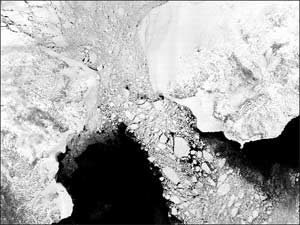The Siberia region begins to thaw
 The European Aeronautics Agency (ESA) said for the first time since 11,000 years, the vast Siberia region has begun to thaw, revealing a 4,000-kilometer stretch of green pasture that is visible through the satellite photo.
The European Aeronautics Agency (ESA) said for the first time since 11,000 years, the vast Siberia region has begun to thaw, revealing a 4,000-kilometer stretch of green pasture that is visible through the satellite photo.
Siberia stretches from the Uranian Range to the West to Okhot Sea in the East, from the Arctic Ocean to the borders of Kazakstan, Mongolia and China. This frozen year-round land is strongly affected by global warming. Statistics show that in some parts of Siberia temperatures have increased by 3 degrees Celsius in the past 40 years.
Western Siberia is the largest concentration of peat reserves in the world. According to ESA, these coal mines contain billions of tons of greenhouse gases such as metal and CO2, and when the ice melts, they will escape to the atmosphere, contributing significantly to warming the Earth's climate. .
- Appeared more mysterious craters in Siberia
- Meteors explode into night in Siberia
- Russia, North America and Japan can merge into supercontinent
- The mysterious crater in Siberia houses a 25-storey building
- Strong earthquake in Russia
- The brain begins to die after age 45
- Russia evacuated tens of thousands of people because of flooding
- UFOs appear in Siberia in a row that scared people
- Strange black snow in Siberia
- Red rain in Siberia blood causes fear of the end of the world
- Blizzard 'devour' Siberia city in the cold of -50 degrees Celsius
- Strong earthquake in Russia
 Is the magnetic North Pole shift dangerous to humanity?
Is the magnetic North Pole shift dangerous to humanity? Washington legalizes the recycling of human bodies into fertilizer
Washington legalizes the recycling of human bodies into fertilizer Lightning stone - the mysterious guest
Lightning stone - the mysterious guest Stunned by the mysterious sunset, strange appearance
Stunned by the mysterious sunset, strange appearance